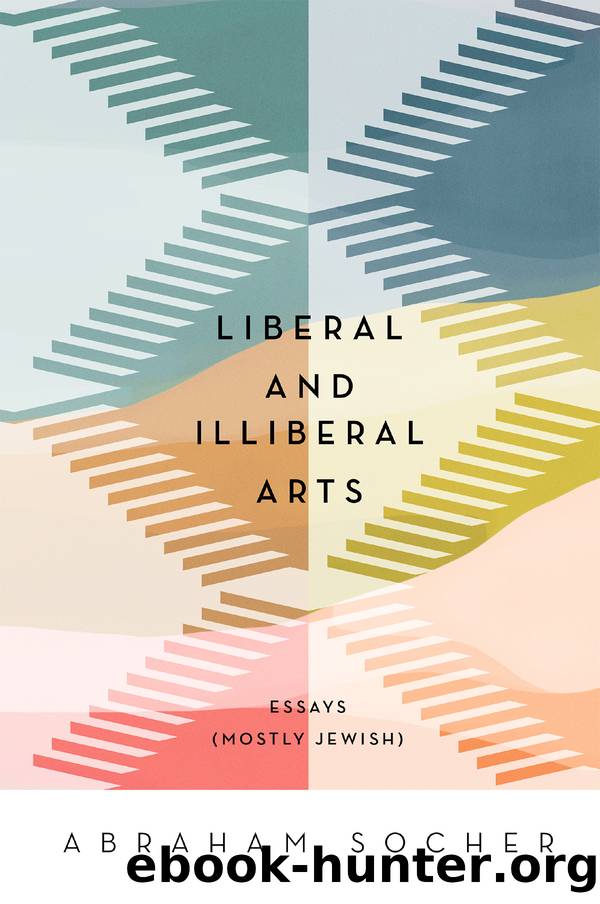Liberal and Illiberal Arts by Abraham Socher

Author:Abraham Socher
Language: eng
Format: epub
Publisher: Paul Dry Books
Published: 2022-01-15T00:00:00+00:00
Cynthia Ozickâs Dictation
IN A REVIEW of Saul Bellowâs Him With His Foot in His Mouth, a book of five short stories, Cynthia Ozick asked:
Does there come a time when, out of the blue, an author offers to decode himself? Not simply to divert, or paraphrase, or lead around a corner, or leave clues, or set out decoys (familiar apparatus, art-as-usual), but⦠spill wine all over the figure in the carpet ⦠and disclose the thing itself? To let loose, in fact, the secret? ⦠The cumulative art, concentrated, so to speak, in a vial?
Now, at a similarly late stage in her career, Ozick has collected four stories of her own, âa quartet,â as the subtitle of her new book has it, and one is tempted to ask the same question. Has Ozick offered to decode herself?
Perhapsâthough it should be noted that it was never clear that Bellowâs one true subject, his âsecret,â was, as Ozick claimed, âthe Eye of Godâ (âthe Wit of Saulâ might come closer). Ozick is, like Bellow, known as a Jewish writer, but unlike Bellow, who once criticized Isaac Bashevis Singer as âtoo Jewy,â she has not resisted the label or dismissed it as socio-historical happenstance. To the contrary, the question of what it means to write as a Jew has always been at the center of Ozickâs work.
Her first published short story, âThe Pagan Rabbiâ (1966), depicts a rabbinic scholar who tells his children fantastic tales, comes to worship nature, and, in a fit of despair and ecstasy, ends up hanging himself from a tree with his tallit (prayer shawl). The central character of her most successful novel, The Cannibal Galaxy (1983), is a Jewish educator whose great ambition is to lead a school that marries the best of the Jewish and classical traditions; he fails. Ozickâs 2004 novel Heir to the Glimmering World manages to be at once about a figure very much like Christopher Milne, the unhappy model for his fatherâs âWinnie the Poohâ stories, and about the medieval Jewish heresy of Karaism, which rejected rabbinic commentary in favor of biblical literalism.
Ozick, of all Jewish American writers, has been most concerned with God and His demands. Not the âGod-idea,â or ecstatic spiritual experience, but the biblical God of Sinai Who announces Himself as utterly unique and prohibits the worship of anything else or its image âin the form of the heaven above, or on the earth beneath, or in the water under the earth.â
Is art, thenâthe image-making and image-worshiping activity par excellenceâa violation of Godâs command? Is art idolatrous? This conundrum underlies Ozickâs fiction and has inspired some of her most incisive criticism. Her answer would appear to be a tough-minded yes, with the caveat that the conundrum is also inescapable. Art for artâs sake is, in Ozickâs judgment, the worship of images, lumps of inert clay or heaps of mere words. But writers and artists necessarily come to the beauty of the created world late, and in their rapture cannot help wishing to usurp the primal creativity, rivaling God and proclaiming their human handiwork very good.
Download
This site does not store any files on its server. We only index and link to content provided by other sites. Please contact the content providers to delete copyright contents if any and email us, we'll remove relevant links or contents immediately.
| African | Asian |
| Australian & Oceanian | Canadian |
| Caribbean & Latin American | European |
| Jewish | Middle Eastern |
| Russian | United States |
4 3 2 1: A Novel by Paul Auster(12182)
The handmaid's tale by Margaret Atwood(7626)
Giovanni's Room by James Baldwin(7096)
Asking the Right Questions: A Guide to Critical Thinking by M. Neil Browne & Stuart M. Keeley(5565)
Big Magic: Creative Living Beyond Fear by Elizabeth Gilbert(5541)
Ego Is the Enemy by Ryan Holiday(5211)
The Body: A Guide for Occupants by Bill Bryson(4860)
On Writing A Memoir of the Craft by Stephen King(4809)
Ken Follett - World without end by Ken Follett(4581)
Adulting by Kelly Williams Brown(4425)
Bluets by Maggie Nelson(4420)
Eat That Frog! by Brian Tracy(4357)
Guilty Pleasures by Laurell K Hamilton(4257)
The Poetry of Pablo Neruda by Pablo Neruda(3969)
Alive: The Story of the Andes Survivors by Piers Paul Read(3905)
White Noise - A Novel by Don DeLillo(3905)
Fingerprints of the Gods by Graham Hancock(3872)
The Book of Joy by Dalai Lama(3840)
The Bookshop by Penelope Fitzgerald(3707)
